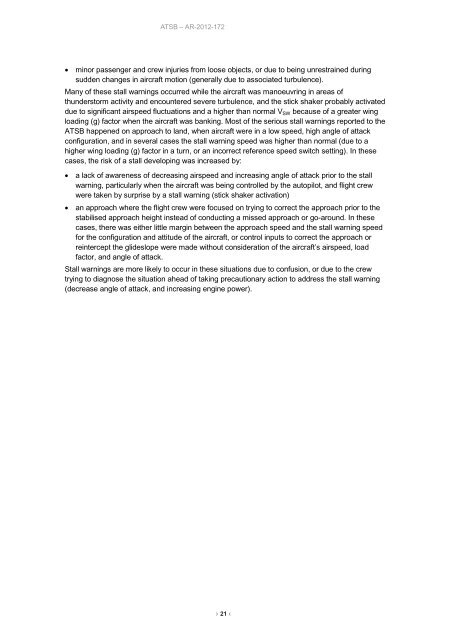Stall warnings in high capacity aircraft: The Australian context 2008 ...
Stall warnings in high capacity aircraft: The Australian context 2008 ...
Stall warnings in high capacity aircraft: The Australian context 2008 ...
You also want an ePaper? Increase the reach of your titles
YUMPU automatically turns print PDFs into web optimized ePapers that Google loves.
ATSB – AR-2012-172<br />
• m<strong>in</strong>or passenger and crew <strong>in</strong>juries from loose objects, or due to be<strong>in</strong>g unrestra<strong>in</strong>ed dur<strong>in</strong>g<br />
sudden changes <strong>in</strong> <strong>aircraft</strong> motion (generally due to associated turbulence).<br />
Many of these stall <strong>warn<strong>in</strong>gs</strong> occurred while the <strong>aircraft</strong> was manoeuvr<strong>in</strong>g <strong>in</strong> areas of<br />
thunderstorm activity and encountered severe turbulence, and the stick shaker probably activated<br />
due to significant airspeed fluctuations and a <strong>high</strong>er than normal V SW because of a greater w<strong>in</strong>g<br />
load<strong>in</strong>g (g) factor when the <strong>aircraft</strong> was bank<strong>in</strong>g. Most of the serious stall <strong>warn<strong>in</strong>gs</strong> reported to the<br />
ATSB happened on approach to land, when <strong>aircraft</strong> were <strong>in</strong> a low speed, <strong>high</strong> angle of attack<br />
configuration, and <strong>in</strong> several cases the stall warn<strong>in</strong>g speed was <strong>high</strong>er than normal (due to a<br />
<strong>high</strong>er w<strong>in</strong>g load<strong>in</strong>g (g) factor <strong>in</strong> a turn, or an <strong>in</strong>correct reference speed switch sett<strong>in</strong>g). In these<br />
cases, the risk of a stall develop<strong>in</strong>g was <strong>in</strong>creased by:<br />
• a lack of awareness of decreas<strong>in</strong>g airspeed and <strong>in</strong>creas<strong>in</strong>g angle of attack prior to the stall<br />
warn<strong>in</strong>g, particularly when the <strong>aircraft</strong> was be<strong>in</strong>g controlled by the autopilot, and flight crew<br />
were taken by surprise by a stall warn<strong>in</strong>g (stick shaker activation)<br />
• an approach where the flight crew were focused on try<strong>in</strong>g to correct the approach prior to the<br />
stabilised approach height <strong>in</strong>stead of conduct<strong>in</strong>g a missed approach or go-around. In these<br />
cases, there was either little marg<strong>in</strong> between the approach speed and the stall warn<strong>in</strong>g speed<br />
for the configuration and attitude of the <strong>aircraft</strong>, or control <strong>in</strong>puts to correct the approach or<br />
re<strong>in</strong>tercept the glideslope were made without consideration of the <strong>aircraft</strong>’s airspeed, load<br />
factor, and angle of attack.<br />
<strong>Stall</strong> <strong>warn<strong>in</strong>gs</strong> are more likely to occur <strong>in</strong> these situations due to confusion, or due to the crew<br />
try<strong>in</strong>g to diagnose the situation ahead of tak<strong>in</strong>g precautionary action to address the stall warn<strong>in</strong>g<br />
(decrease angle of attack, and <strong>in</strong>creas<strong>in</strong>g eng<strong>in</strong>e power).<br />
› 21 ‹
















